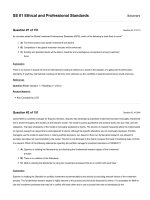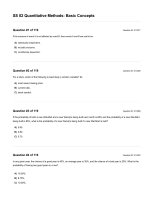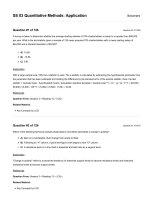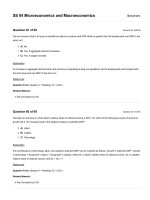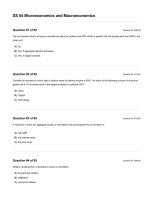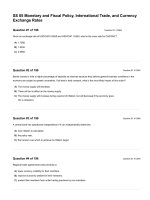CFA 2019 - level 1 schwesernotes book 1
Bạn đang xem bản rút gọn của tài liệu. Xem và tải ngay bản đầy đủ của tài liệu tại đây (15.34 MB, 316 trang )
Contents
1. Welcome to the 2019 SchweserNotes™
2. Learning Outcome Statements (LOS)
3. Study Session 1—Ethical and Professional Standards
1. Reading 1: Ethics and Trust in the Investment Profession
1. Exam Focus
2. Module 1.1: Ethics and Trust
3. Key Concepts
4. Answer Key for Module Quiz
2. Reading 2: Code of Ethics and Standards of Professional Conduct
1. Exam Focus
2. Module 2.1: Code and Standards
3. Answer Key for Module Quiz
3. Reading 3: Guidance for Standards I–VII
1. Exam Focus
2. Module 3.1: Guidance for Standards I(A) and I(B)
3. Module 3.2: Guidance for Standards I(C) and I(D)
4. Module 3.3: Guidance for Standard II
5. Module 3.4: Guidance for Standards III(A) and III(B)
6. Module 3.5: Guidance for Standards III(C), III(D), and III(E)
7. Module 3.6: Guidance for Standard IV
8. Module 3.7: Guidance for Standard V
9. Module 3.8: Guidance for Standard VI
10. Module 3.9: Guidance for Standard VII
11. Answer Key for Module Quizzes
4. Reading 4: Introduction to the Global Investment Performance Standards
(GIPS®)
1. Exam Focus
2. Module 4.1: Introduction to GIPS
3. Key Concepts
4. Answer Key for Module Quiz
5. Reading 5: The GIPS Standards
1. Module 5.1: The GIPS Standards
2. Key Concepts
3. Answer Key for Module Quiz
4. Topic Assessment: Ethical and Professional Standards
5. Topic Assessment Answers: Ethical and Professional Standards
6. Study Session 2—Quantitative Methods (1)
1. Reading 6: The Time Value of Money
1. Exam Focus
2. Module 6.1: EAY and Compounding Frequency
3. Module 6.2: Calculating PV and FV
4. Module 6.3: Uneven Cash Flows
5. Key Concepts
6. Answer Key for Module Quizzes
2. Reading 7: Discounted Cash Flow Applications
1. Exam Focus
2. Module 7.1: NPV, IRR, and HPR
3. Module 7.2: Returns and Yields
4. Key Concepts
5. Answer Key for Module Quizzes
3. Reading 8: Statistical Concepts and Market Returns
1. Exam Focus
2. Module 8.1 Describing Data Sets
3. Module 8.2: Means and Variance
4. Module 8.3: Skew, Kurtosis, and Sharpe Ratio
5. Key Concepts
6. Answer Key for Module Quizzes
4. Reading 9: Probability Concepts
1. Exam Focus
2. Module 9.1: Conditional and Joint Probabilities
3. Module 9.2: Conditional Expectations, Correlation
4. Module 9.3: Portfolio Variance, Bayes, and Counting Problems
5. Key Concepts
6. Answer Key for Module Quizzes
7. Study Session 3—Quantitative Methods (2)
1. Reading 10: Common Probability Distributions
1. Exam Focus
2. Module 10.1: Uniform and Binomial Distributions
3. Module 10.2: Normal Distributions
4. Module 10.3: Lognormal Distribution, Simulations
5. Key Concepts
6. Answer Key for Module Quizzes
2. Reading 11: Sampling and Estimation
1. Exam Focus
2. Module 11.1: Central Limit Theorem and Standard Error
3. Module 11.2: Confidence Intervals and t-Distribution
4. Key Concepts
5. Answer Key for Module Quizzes
3. Reading 12: Hypothesis Testing
1. Exam Focus
2. Module 12.1: Hypothesis Tests and Types of Errors
3. Module 12.2: Tests of Means and p-Values
4. Module 12.3: Mean Differences, Difference in Means
5. Key Concepts
6. Answer Key for Module Quizzes
4. Reading 13: Technical Analysis
1. Exam Focus
2. Module 13.1: Technical Analysis
专业提供CFA/FRM/AQF视频课程资料 微信:fcayyh
8.
9.
10.
11.
3. Key Concepts
4. Answer Key for Module Quiz
Topic Assessment: Quantitative Methods
Topic Assessment Answers: Quantitative Methods
Formulas
Appendices
1. Appendix A: Areas Under The Normal Curve
2. Cumulative Z-Table
3. Appendix B: Student’s t-Distribution
4. Appendix C: F-Table at 5% (Upper Tail)
5. Appendix D: F-Table at 2.5% (Upper Tail)
6. Appendix E: Chi-Squared table
List of pages
1.
2.
3.
4.
5.
6.
7.
8.
9.
10.
11.
12.
13.
14.
15.
16.
17.
18.
19.
20.
21.
22.
23.
24.
25.
26.
27.
28.
29.
30.
31.
32.
33.
34.
35.
36.
37.
38.
39.
40.
41.
42.
i
iv
ix
x
xi
xii
xiii
xiv
xv
1
2
3
4
5
6
7
9
10
11
12
13
14
15
16
17
18
19
20
21
23
24
25
26
27
28
29
30
31
32
33
34
35
43.
44.
45.
46.
47.
48.
49.
50.
51.
52.
53.
54.
55.
56.
57.
58.
59.
60.
61.
62.
63.
64.
65.
66.
67.
68.
69.
70.
71.
72.
73.
74.
75.
76.
77.
78.
79.
80.
81.
82.
83.
84.
85.
86.
87.
88.
36
37
38
39
40
41
42
43
44
45
46
47
48
49
50
51
53
54
55
56
57
58
59
60
61
63
64
65
66
67
68
69
70
71
72
73
74
75
76
77
78
79
80
81
82
83
89.
90.
91.
92.
93.
94.
95.
96.
97.
98.
99.
100.
101.
102.
103.
104.
105.
106.
107.
108.
109.
110.
111.
112.
113.
114.
115.
116.
117.
118.
119.
120.
121.
122.
123.
124.
125.
126.
127.
128.
129.
130.
131.
132.
133.
134.
84
85
86
87
88
89
90
91
92
93
94
95
97
98
99
100
101
102
103
104
105
106
107
108
109
110
111
112
113
114
115
116
117
119
120
121
122
123
124
125
126
127
128
129
130
131
135.
136.
137.
138.
139.
140.
141.
142.
143.
144.
145.
146.
147.
148.
149.
150.
151.
152.
153.
154.
155.
156.
157.
158.
159.
160.
161.
162.
163.
164.
165.
166.
167.
168.
169.
170.
171.
172.
173.
174.
175.
176.
177.
178.
179.
180.
132
133
134
135
136
137
138
139
140
141
142
143
144
145
146
147
148
149
150
151
152
153
155
156
157
158
159
160
161
162
163
164
165
167
168
169
170
171
172
173
175
176
177
178
179
181
181.
182.
183.
184.
185.
186.
187.
188.
189.
190.
191.
192.
193.
194.
195.
196.
197.
198.
199.
200.
201.
202.
203.
204.
205.
206.
207.
208.
209.
210.
211.
212.
213.
214.
215.
216.
217.
218.
219.
220.
221.
222.
223.
224.
225.
226.
182
183
184
185
186
187
188
189
190
191
192
193
194
195
196
197
198
199
200
201
202
203
205
206
207
208
209
210
211
212
213
214
215
216
217
218
219
220
221
222
223
224
225
226
227
228
227.
228.
229.
230.
231.
232.
233.
234.
235.
236.
237.
238.
239.
240.
241.
242.
243.
244.
245.
246.
247.
248.
249.
250.
251.
252.
253.
254.
255.
256.
257.
258.
259.
260.
261.
262.
263.
264.
265.
266.
267.
268.
269.
270.
271.
272.
229
230
231
232
233
234
235
236
237
238
239
240
241
242
243
244
245
246
247
248
249
250
251
252
253
254
255
256
257
258
259
260
261
262
263
264
265
266
267
269
270
271
272
273
274
275
273.
274.
275.
276.
277.
278.
279.
280.
281.
282.
283.
284.
285.
286.
287.
288.
289.
290.
291.
292.
293.
294.
295.
296.
297.
298.
299.
276
277
278
279
280
281
282
283
284
285
287
288
289
290
291
293
294
295
296
297
298
299
300
301
302
303
304
Kaplan Schweser’s Path to Success
Level I CFA® Exam
Welcome
As the head of Advanced Designations at Kaplan Schweser, I am pleased to have the opportunity to
help you prepare for the CFA® exam. Kaplan Schweser has decades of experience in delivering the
most effective CFA exam prep products in the market and I know you will find them to be invaluable in
your studies.
专业提供CFA/FRM/AQF视频课程资料 微信:fcayyh
Our products are designed to be an integrated study solution across print and digital media to provide
you the best learning experience, whether you are studying with a physical book, online, or on your
mobile device.
Our core product, the SchweserNotes™, addresses all of the Topics, Study Sessions, Readings, and
LOS in the CFA curriculum. Each reading in the SchweserNotes has been broken into smaller, bite-sized
modules with Module Quizzes interspersed throughout to help you continually assess your
comprehension. Topic Assessments appear at the end of each Topic to help you assess your knowledge
of the material before you move on to the next section.
All purchasers of the SchweserNotes receive online access to the Kaplan Schweser online platform (our
learning management system or LMS) at www.Schweser.com. In the LMS, you will see a dashboard that
tracks your overall progress and performance and also includes an Activity Feed, which provides
structure and organization to the tasks required to prepare for the CFA exam. You also have access to
the SchweserNotes, Module Quizzes, and Topic Assessments content as well as the Video Lectures (if
purchased), which contain a short video that complements each module in the SchweserNotes. Look for
the icons indicating where video content, Module Quizzes, and Topic Assessments are available online. I
strongly encourage you to enter your Module Quiz and Topic Assessment answers online and use the
dashboard to track your progress and stay motivated.
Again, thank you for trusting Kaplan Schweser with your CFA exam preparation. We’re here to help you
throughout your journey to become a CFA charterholder.
Regards,
Derek Burkett
Derek Burkett, CFA, FRM, CAIA
Vice President (Advanced Designations)
Contact us for questions about your study package, upgrading your package, purchasing
additional study materials, or for additional information:
888.325.5072 (U.S.) | +1 608.779.8327 (Int’l.)
| www.schweser.com/cfa
WELCOME TO THE 2019
SCHWESERNOTES™
Thank you for trusting Kaplan Schweser to help you pass the Level I CFA exam. You
have made an exceptionally good decision, and we congratulate you for taking on the
challenge of earning your CFA charter.
Your first step should be to view the “How to Pass the Level I CFA Exam” video
(available in your Resource Library), in which I explain the structure of the Level I
exam, the format of exam questions, and topic area exam weights. We also provide
advice on interpreting the (500+) Level I CFA Learning Outcome Statements (LOS),
how to create an effective study plan, and study techniques based on research in
learning science. Understanding the exact nature of the challenge you have taken on is
an important first step in preparing to pass the Level I CFA exam.
The next step is to study and learn the material required for the exam. The best time to
begin that study is today (regardless of when you are reading this). Less than 40% of
those who register for a Level I exam pass the exam (including re-takers). For many,
passing the exam is a formidable challenge. One of reasons candidates give most
frequently for failing is “not starting early enough.”
Begin your study today with Study Session 2, Quantitative Methods, and progress
through Study Session 19, Alternative Investments, over the coming months. Complete
your initial study of the Level I CFA curriculum with Study Session 1, Ethical and
Professional Standards. While the SchweserNotes provide an excellent summary of the
required material for Study Session 1, we strongly recommend that, for this material, all
candidates also study the CFA Institute Code of Ethics and Standards of Professional
Conduct (Readings 2 and 3 in the Level I CFA Curriculum, Volume 1) at this point and
again shortly before the exam.
It is very important to finish your initial study of the entire curriculum at least one
month (earlier if possible) prior to your exam date to allow sufficient time for practice
and targeted review. During this period, you should take all the Schweser Practice
Exams. Two weeks prior to the exam you should take the Schweser Mock Exam, which
is offered by CFA Societies in well over 100 locations worldwide, as well as online for
those who can’t make it to a live Schweser Mock. This final review period is when you
will get a clear indication of how effective your study has been and which topic areas
require significant additional review on your part. Practice answering exam-like
questions across all topic areas and working on your exam timing will be important
determinants of your success on exam day.
Finally, I would like to thank my assistant, Craig Prochaska, CFA, who has been
invaluable in the preparation of all our Level I study materials and candidate support for
13 years. Craig and I will be answering your questions and supporting your study
throughout the exam season.
Best regards,
Doug Van Eaton
Doug Van Eaton, PhD, CFA
SVP for CFA Education
Kaplan Schweser
LEARNING OUTCOME STATEMENTS (LOS)
STUDY SESSION 1
This topical coverage corresponds with the following CFA Institute assigned reading:
1. Ethics and Trust in the Investment Profession
The candidate should be able to:
a. explain ethics. (page 1)
b. describe the role of a code of ethics in defining a profession. (page 2)
c. identify challenges to ethical behavior. (page 2)
d. describe the need for high ethical standards in the investment industry. (page 2)
e. distinguish between ethical and legal standards. (page 3)
f. describe and apply a framework for ethical decision making. (page 4)
This topical coverage corresponds with the following CFA Institute assigned reading:
2. Code of Ethics and Standards of Professional Conduct
The candidate should be able to:
a. describe the structure of the CFA Institute Professional Conduct Program and the
process for the enforcement of the Code and Standards. (page 9)
b. state the six components of the Code of Ethics and the seven Standards of
Professional Conduct. (page 10)
c. explain the ethical responsibilities required by the Code and Standards, including
the sub-sections of each Standard. (page 11)
This topical coverage corresponds with the following CFA Institute assigned reading:
3. Guidance for Standards I–VII
The candidate should be able to:
a. demonstrate the application of the Code of Ethics and Standards of Professional
Conduct to situations involving issues of professional integrity. (page 17)
b. distinguish between conduct that conforms to the Code and Standards and conduct
that violates the Code and Standards. (page 17)
c. recommend practices and procedures designed to prevent violations of the Code of
Ethics and Standards of Professional Conduct. (page 17)
This topical coverage corresponds with the following CFA Institute assigned reading:
4. Introduction to the Global Investment Performance Standards
(GIPS®)
The candidate should be able to:
a. explain why the GIPS standards were created, what parties the GIPS standards
apply to, and who is served by the standards. (page 47)
b. explain the construction and purpose of composites in performance
reporting.(page 48)专业提供CFA/FRM/AQF视频课程资料 微信:fcayyh
c. explain the requirements for verification. (page 48)
This topical coverage corresponds with the following CFA Institute assigned reading:
5. The GIPS Standards
The candidate should be able to:
a. describe the key features of the GIPS standards and the fundamentals of
compliance. (page 53)
b. describe the scope of the GIPS standards with respect to an investment firm’s
definition and historical performance record. (page 55)
c. explain how the GIPS standards are implemented in countries with existing
standards for performance reporting and describe the appropriate response when
the GIPS standards and local regulations conflict. (page 56)
d. describe the nine major sections of the GIPS standards. (page 56)
STUDY SESSION 2
This topical coverage corresponds with the following CFA Institute assigned reading:
6. The Time Value of Money
The candidate should be able to:
a. interpret interest rates as required rates of return, discount rates, or opportunity
costs. (page 73)
b. explain an interest rate as the sum of a real risk-free rate and premiums that
compensate investors for bearing distinct types of risk. (page 74)
c. calculate and interpret the effective annual rate, given the stated annual interest rate
and the frequency of compounding. (page 74)
d. solve time value of money problems for different frequencies of compounding.
(page 76)
e. calculate and interpret the future value (FV) and present value (PV) of a single sum
of money, an ordinary annuity, an annuity due, a perpetuity (PV only), and a series
of unequal cash flows. (page 77)
f. demonstrate the use of a time line in modeling and solving time value of money
problems. (page 89)
This topical coverage corresponds with the following CFA Institute assigned reading:
7. Discounted Cash Flow Applications
The candidate should be able to:
a. calculate and interpret the net present value (NPV) and the internal rate of return
(IRR) of an investment. (page 99)
b. contrast the NPV rule to the IRR rule, and identify problems associated with the
IRR rule. (page 102)
c. calculate and interpret a holding period return (total return). (page 103)
d. calculate and compare the money-weighted and time-weighted rates of return of a
portfolio and evaluate the performance of portfolios based on these measures.
(page 105)
e. calculate and interpret the bank discount yield, holding period yield, effective
annual yield, and money market yield for US Treasury bills and other money
market instruments. (page 108)
f. convert among holding period yields, money market yields, effective annual yields,
and bond equivalent yields. (page 110)
This topical coverage corresponds with the following CFA Institute assigned reading:
8. Statistical Concepts and Market Returns
The candidate should be able to:
a. distinguish between descriptive statistics and inferential statistics, between a
population and a sample, and among the types of measurement scales. (page 119)
b. define a parameter, a sample statistic, and a frequency distribution. (page 121)
c. calculate and interpret relative frequencies and cumulative relative frequencies,
given a frequency distribution. (page 123)
d. describe the properties of a data set presented as a histogram or a frequency
polygon. (page 124)
e. calculate and interpret measures of central tendency, including the population
mean, sample mean, arithmetic mean, weighted average or mean, geometric mean,
harmonic mean, median, and mode. (page 127)
f. calculate and interpret quartiles, quintiles, deciles, and percentiles. (page 131)
g. calculate and interpret 1) a range and a mean absolute deviation and 2) the variance
and standard deviation of a population and of a sample. (page 132)
h. calculate and interpret the proportion of observations falling within a specified
number of standard deviations of the mean using Chebyshev’s inequality. (page
137)
i. calculate and interpret the coefficient of variation and the Sharpe ratio. (page 138)
j. explain skewness and the meaning of a positively or negatively skewed return
distribution. (page 140)
k. describe the relative locations of the mean, median, and mode for a unimodal,
nonsymmetrical distribution. (page 140)
l. explain measures of sample skewness and kurtosis. (page 142)
m. compare the use of arithmetic and geometric means when analyzing investment
returns. (page 143)
This topical coverage corresponds with the following CFA Institute assigned reading:
9. Probability Concepts
The candidate should be able to:
a. define a random variable, an outcome, an event, mutually exclusive events, and
exhaustive events. (page 153)
b. state the two defining properties of probability and distinguish among empirical,
subjective, and a priori probabilities. (page 154)
c. state the probability of an event in terms of odds for and against the event. (page
154)
d. distinguish between unconditional and conditional probabilities. (page 155)
e. explain the multiplication, addition, and total probability rules. (page 155)
f. calculate and interpret 1) the joint probability of two events, 2) the probability that
at least one of two events will occur, given the probability of each and the joint
probability of the two events, and 3) a joint probability of any number of
independent events. (page 156)
g. distinguish between dependent and independent events. (page 159)
h. calculate and interpret an unconditional probability using the total probability rule.
(page 160)
i. explain the use of conditional expectation in investment applications. (page 162)
j. explain the use of a tree diagram to represent an investment problem. (page 162)
k. calculate and interpret covariance and correlation. (page 163)
l. calculate and interpret the expected value, variance, and standard deviation of a
random variable and of returns on a portfolio. (page 166)
m. calculate and interpret covariance given a joint probability function. (page 168)
n. calculate and interpret an updated probability using Bayes’ formula. (page 168)
o. identify the most appropriate method to solve a particular counting problem and
solve counting problems using factorial, combination, and permutation concepts.
(page 170)
STUDY SESSION 3
This topical coverage corresponds with the following CFA Institute assigned reading:
10. Common Probability Distributions
The candidate should be able to:
a. define a probability distribution and distinguish between discrete and continuous
random variables and their probability functions. (page 181)
b. describe the set of possible outcomes of a specified discrete random variable. (page
181)
c. interpret a cumulative distribution function. (page 183)
d. calculate and interpret probabilities for a random variable, given its cumulative
distribution function. (page 183)
e. define a discrete uniform random variable, a Bernoulli random variable, and a
binomial random variable. (page 185)
f. calculate and interpret probabilities given the discrete uniform and the binomial
distribution functions. (page 185)
g. construct a binomial tree to describe stock price movement. (page 187)
h. define the continuous uniform distribution and calculate and interpret probabilities,
given a continuous uniform distribution. (page 189)
i. explain the key properties of the normal distribution. (page 192)
j. distinguish between a univariate and a multivariate distribution and explain the role
of correlation in the multivariate normal distribution. (page 193)
k. determine the probability that a normally distributed random variable lies inside a
given interval. (page 194)
l. define the standard normal distribution, explain how to standardize a random
variable, and calculate and interpret probabilities using the standard normal
distribution. (page 195)
m. define shortfall risk, calculate the safety-first ratio, and select an optimal portfolio
using Roy’s safety-first criterion. (page 199)
n. explain the relationship between normal and lognormal distributions and why the
lognormal distribution is used to model asset prices. (page 202)
o. distinguish between discretely and continuously compounded rates of return and
calculate and interpret a continuously compounded rate of return, given a specific
holding period return. (page 203)
p. explain Monte Carlo simulation and describe its applications and limitations. (page
204)
q. compare Monte Carlo simulation and historical simulation. (page 205)
This topical coverage corresponds with the following CFA Institute assigned reading:
11. Sampling and Estimation
The candidate should be able to:
a. define simple random sampling and a sampling distribution. (page 214)
b. explain sampling error. (page 214)
c. distinguish between simple random and stratified random sampling. (page 215)
d. distinguish between time-series and cross-sectional data. (page 215)
e. explain the central limit theorem and its importance. (page 216)
f. calculate and interpret the standard error of the sample mean. (page 216)
g. identify and describe desirable properties of an estimator. (page 218)
h. distinguish between a point estimate and a confidence interval estimate of a
population parameter. (page 220)
i. describe properties of Student’s t-distribution and calculate and interpret its degrees
of freedom. (page 220)
j. calculate and interpret a confidence interval for a population mean, given a normal
distribution with 1) a known population variance, 2) an unknown population
variance, or 3) an unknown population variance and a large sample size. (page
223)
k. describe the issues regarding selection of the appropriate sample size, data-mining
bias, sample selection bias, survivorship bias, look-ahead bias, and time-period
bias. (page 227)
This topical coverage corresponds with the following CFA Institute assigned reading:
12. Hypothesis Testing
The candidate should be able to:
a. define a hypothesis, describe the steps of hypothesis testing, and describe and
interpret the choice of the null and alternative hypotheses. (page 236)
b. distinguish between one-tailed and two-tailed tests of hypotheses. (page 237)
c. explain a test statistic, Type I and Type II errors, a significance level, and how
significance levels are used in hypothesis testing. (page 239)
d. explain a decision rule, the power of a test, and the relation between confidence
intervals and hypothesis tests. (page 241)
e. distinguish between a statistical result and an economically meaningful result.
(page 244)
f. explain and interpret the p-value as it relates to hypothesis testing. (page 245)
g. identify the appropriate test statistic and interpret the results for a hypothesis test
concerning the population mean of both large and small samples when the
population is normally or approximately normally distributed and the variance is
1) known or 2) unknown. (page 245)
h. identify the appropriate test statistic and interpret the results for a hypothesis test
concerning the equality of the population means of two at least approximately
normally distributed populations, based on independent random samples with 1)
equal or 2) unequal assumed variances. (page 250)
i. identify the appropriate test statistic and interpret the results for a hypothesis test
concerning the mean difference of two normally distributed populations. (page
253)
j. identify the appropriate test statistic and interpret the results for a hypothesis test
concerning 1) the variance of a normally distributed population, and 2) the equality
of the variances of two normally distributed populations based on two independent
random samples. (page 256)
k. distinguish between parametric and nonparametric tests and describe situations in
which the use of nonparametric tests may be appropriate. (page 261)
This topical coverage corresponds with the following CFA Institute assigned reading:
13. Technical Analysis
The candidate should be able to:
a. explain principles of technical analysis, its applications, and its underlying
assumptions. (page 269)
b. describe the construction of different types of technical analysis charts and
interpret them. (page 270)
c. explain uses of trend, support, resistance lines, and change in polarity. (page 273)
d. describe common chart patterns. (page 274)
e. describe common technical analysis indicators (price-based, momentum
oscillators, sentiment, and flow of funds). (page 276)
f. explain how technical analysts use cycles. (page 280)
g. describe the key tenets of Elliott Wave Theory and the importance of Fibonacci
numbers. (page 280)
h. describe intermarket analysis as it relates to technical analysis and asset allocation.
(page 281)
The following is a review of the Ethical and Professional Standards principles designed to address the
learning outcome statements set forth by CFA Institute. Cross-Reference to CFA Institute Assigned
Reading #1.
READING 1: ETHICS AND TRUST IN THE
INVESTMENT PROFESSION
Study Session 1
EXAM FOCUS
From this reading, candidates should learn the definitions of ethics and ethical behavior
presented by the authors and the arguments presented for having a code of ethics and
following ethical principles. Additionally, the arguments for integrating ethics into the
decision-making process include testable material.
MODULE 1.1: ETHICS AND TRUST
LOS 1.a: Explain ethics.
Video covering
this content is
available online.
CFA® Program Curriculum, Volume 1, page 6
Ethics can be described as a set of shared beliefs about what is good or acceptable
behavior and what is bad or unacceptable behavior. Ethics also refers to the study of
good and bad behavior. Ethical conduct has been described as behavior that follows
moral principles and is consistent with society’s ethical expectations.
Ethical conduct has also been described as conduct that improves outcomes for
stakeholders, who are people directly or indirectly affected by the conduct. Examples
of stakeholders in the case of investment professionals include their clients, coworkers,
employers, and the investment profession as a whole. Some decisions may bring
positive results for you, but negative consequences for a stakeholder, such as a
coworker. Ethical conduct is behavior that balances your self-interest with the impact on
others.
LOS 1.b: Describe the role of a code of ethics in defining a profession.
CFA® Program Curriculum, Volume 1, page 9
A code of ethics is a written set of moral principles that can guide behavior by
describing what is considered acceptable behavior. Having a code of ethics is a way to
communicate the values, principles, and expectations of an organization or other group
of people and provides a general guide to what constitutes acceptable behavior. Some
codes of ethics include a set of rules or standards that require some minimum level of
ethical behavior.
A profession refers to a group of people with specialized skills and knowledge who
serve others and agree to behave in accordance with a code of ethics. A professional
code of ethics is a way for a profession to communicate to the public that its members
will use their knowledge and skills to serve their clients in an honest and ethical manner.
LOS 1.c: Identify challenges to ethical behavior.
CFA® Program Curriculum, Volume 1, page 11
One challenge to ethical behavior is that individuals tend to overrate the ethical quality
of their behavior on a relative basis and overemphasize the importance of their own
personal traits in determining the ethical quality of their behavior.
It is claimed that external or situational influences are a more important determinant of
the ethical quality of behavior than internal (personal) traits that influence behavior.
One situational influence is social pressure from others. Loyalty to an employer,
supervisor, organization, or coworkers can cause individuals to act in unethical ways as
they place more importance on their self-interest and short-term results than on longerterm results and the ethical quality of their decisions and behavior. The prospect of
acquiring more money or greater prestige can cause individuals to engage in unethical
behavior.
Firms with strict rules-based compliance procedures run the risk of fostering a culture
that is so focused on adhering to compliance rules that individuals only ask themselves
what they can do. The question of what behavior they should engage in, based on
ethical principles and longer-term results, is often not addressed in such situations.
LOS 1.d: Describe the need for high ethical standards in the investment industry.
CFA® Program Curriculum, Volume 1, page 15
Investment professionals have a special responsibility because they are entrusted with
their clients’ wealth. The responsibility to use their specialized knowledge and skills to
both protect and grow client assets makes high ethical standards all the more important.
Investment advice and management are intangible products, making quality and value
received more difficult to evaluate than for tangible products such as a laptop computer
or a restaurant meal. For this reason, trust in investment professionals takes on an even
greater importance than in many other businesses.
Failure to act in a highly ethical manner can damage not only client wealth but also
impede the success of investment firms and investment professionals because potential
investors will be less likely to use their services.
Unethical behavior by financial services professionals can have negative effects for
society as a whole. The financial services industry serves as an intermediary between
savers and those seeking financing for their business activities. A lack of trust in
financial advisors will reduce the funds entrusted to them and increase the cost of
raising capital for business investment and growth. When investors cannot rely on the
information they receive from financial services professionals, this adds another layer of
risk on top of the investment risks that investors face. Even the perception of additional
risk will reduce the amounts invested and increase the returns required to attract
investor capital.
